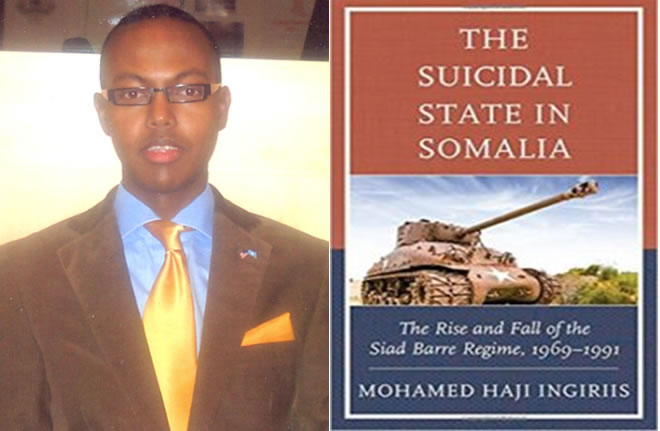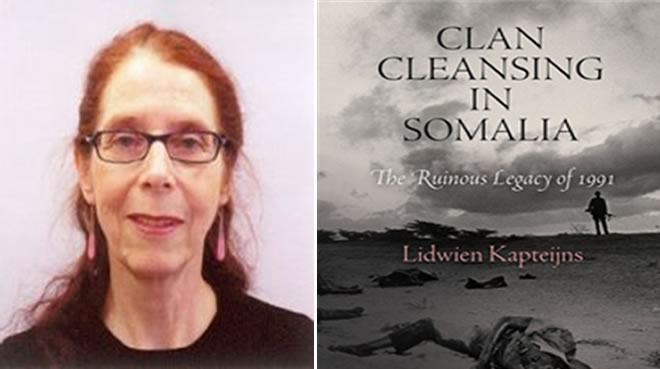by Mohamed Haji Ingiriis
Monday, April 17, 2017

It is my belief that readers of Lidwien Kapteijns’ review of my book, The Suicidal State in Somalia: The Rise and Fall of the Siad Barre Regime, 1969-1991 (2016), posted on Wardheernews website, deserve some factual corrections and explanations for proper contextualisation and comprehension. I welcome that Kapteijns decided to read and write a review of my book, but I would not let go unanswered inaccurate interpretations, false assertions, and insinuations that mar her reading of – and revenge on – my book. I pass up her snide remarks about my age, Somali origin and my proficiency of the English language, which she apparently felt pain to grasp. Ad hominem attacks do not, by nature, interest me.

Without belabouring the unworthy harangues, I will in the following paragraphs rebut the few (seemingly relevant) points she made in her assaults on my book. First and foremost, neither I nor Kapteijns are native speakers of English. No one can claim Englishness better than any other. It is thus strange that she points out grammatical slips. That was my publisher’s problem, not mine. But she made this odd point despite her own review of the book is laced with grammatical mistakes. Readers can check the errors in few paragraphs of her review, including the last sentence of the opening paragraph. Beyond that it does not behove me to indulge in a spat with her usual diatribe.
However, it is a pleasure that Kapteijns took note of my book; I only wish she had read it with patience, for that would have steered her away from rehashing recycled and disproved clannish narratives. However, her reading of my book misleads the reader into believing that what is before them is a comprehensive review of an author’s work. Her review deceptively reads my book on the basis of only two chapters out of 11 long and exhaustive chapters. Her irritations with the two chapters in question become palpable when readers peruse and reflect on the kind of evidence on offer: they bring to the fore new evidence from previously inaccessible rare archival sources, complemented by thoroughly vetted oral testimonies that refute the basic tenets in Kapteijins’ clan-sponsored narratives.
I can brag (proudly, dare I say) that it is normally an exceptional – even outstanding – for a PhD candidate like me to write a book before completing his or her doctoral work. The main objectives of writing my book were, among other reasons, (1) to uncover Kapteijins’ blind blemishes and, ironically, (2) to expose her utter disregard for ‘the referential dimension of history’, to appropriate her quotation from LaCapra. Kapteijns’ ad hominem attacks and her sly comments on parts of my book do perhaps prove that I achieved both objectives. This reminds me of a Somali saying, ‘raaciyadii iyo rucrucdii raamsadaa helay’.
Readers should know in advance that The Suicidal State in Somalia is among other works recently written to correct the historical blunders, biases and distortions propagated in the 2013 fictitious book of Kapteijns, Clan Cleansing in Somalia: The Ruinous Legacy of 1991, in which she attempted unsuccessfully to assist certain clan politicians’ ambitions to grab state power by catering to selective, highly partisan and deeply clanised ‘victimhood’ narratives. My book, The Suicidal State in Somalia, and my other scholarly works challenge the veracity of Kapteijins’ untenable arguments in Clan Cleansing. To advance a new and plausible argument, I interviewed members from all Somali clans living inside and outside of Somalia, while Kapteijns interviewed Diaspora people from a single clan, exclusively from the Mohamoud Saleebaan/Majeerteen, her in-laws. Historians are like judges in a court of law. How can a judge reach a verdict without hearing the defendant or talking to the all parts involved equally? This probably is the reason why she does not highlight the objectivity and neutrality of my objective book, because there is not even the slightest sliver of fairness in her book. It is not a coincidence that Kapteijns was recently commissioned by Abdiweli Ali Gaas, a clan ruler in northeast Somalia, to write an exaggerated autobiography and through this familial (in-law) relationship, she visited Somalia for the second time since her brief sojourn in 1989.
Kapteijns makes false claims over how I used newly-excavated primary sources, which, as she conceded, was one of the main strengths of my book. When I gave detailed references on the Mau Mau anti-colonial uprising, I explicitly suggested that the works I enumerated, written by notable scholars on the subject, explore brutalities that occurred during the Mau Mau era. Nowhere had I noted that those works carried a passage about Siad Barre or his regime. This fabrication on her part is one way of inventing an error in my book. As she could not find a factual error with which to quibble, she took the freedom to fabricate one. I knew Kapteijns will look for everything and every way she could to defend her clan cleansing hate-mongering campaign, but I felt amused of her type of defence. Unable to produce any tangible proof to challenge or refute my arguments, Kapteijins finally felt hard not to be impressed by my dedication to Somali scholarship. Indeed, since the publication of The Suicidal State in Somalia, I have received overwhelming messages from Somalis and non-Somalis praising the book, with one reader reassuring thus: ‘Sir, your book is one of the best scholarly books on Somalia I have ever read or seen; the details are staggering and I want to say thank you, please continue with this great work of re-appraising Somali history’.
By contrast, lacking any nuanced understanding of the Somali conflict, Clan Cleansing book neither carries original data nor provides empirical facts. It is all about regurgitating what has already been on the public domain to back up clan-held prepositions. Her aims appear to be underpinning her discredited point of the myth of ‘clan cleansing’. This is not some idle supposition on my part. The reader need only refer to Kapteijns’ previous feral response to Professor David Laitin’s sober and highly nuanced deconstruction of her ‘clan cleansing’ project. Of note is that Laitin did his PhD on Somali politics, history and literature in 1974, while she had done her PhD on Nigerian historiography in 1977. Moreover, Laitin is now a world class scholar.
I, myself, wrote several critical reviews of Clan Cleansing book and, I daresay, her review of The Suicidal State in Somalia is payback. Readers can consult my papers: (1) ‘Methodological Misjudgments: The Myth of Clan Cleansing’ (published by African Journal of History and Culture in 2016); (2) ‘Unmasking the Wolf in Sheep’s Clothing: Towards a Critique of the Conflicting Historiographies in Somalia’ (published by Global Journal of Human Social Science in 2016), (3) ‘The Psychology and Philosophy of the African Conflicts: Towards Critique of the War Narratives in Somalia and Rwanda’ (published by Conflict Studies Quarterly in 2016); (4) ‘Many Somalia(s), Multiple Memories: Remembrance as Present Politics, Past Politics as Remembrance’ (published by African Identities in 2016); and (5) From Clan Cleansing to Galaal Cleansing: Lidwien Kapteijns’ False and Fabrications in Somali Studies (forthcoming with Méthod(e)s: Revue Africaine de Méthodologie des Sciences Sociales/African Review of Social Science Methodology in 2017). I also wrote two different book reviews appeared in Africa Today and Anglo-Somali Society Journal. Bearing these in mind, Kapteijns had now acted in retaliation for my series of articles and reviews exposing her fantasies and fictions. However, it is strange how can she dare to argue on Somali history with a Somali scholar, who was born and bred in Somalia.
In my book, I showed how the Siad Barre regime sowed the seeds of the Somali civil war and state collapse, although Kapteijns attributed it to a specific clan-group and what she called ‘politico-military’ leaders. By contrast, I emphasised the agency of institutions, not individuals, let alone clan or clans. Individual men like Siad Barre, I argued, used the clan system to advance their interests for holding onto power. The talk about the land expropriation during the Siad regime in Kapteijns’ review is a distraction from the ‘clan cleansing’ fabrication in 1991. I am accused of arguing (and here I am in good company with venerable scholars like Professor Laitin) that clan identities, clan sentiments and military dictatorship played central role in the eruption of the ‘civil’ war, which I conceptualised clanised war. The most bewildering point in her book – which I am sure proponents of the ‘clan cleansing’ project will not be in favour – is when Kapteijns charges Aden Abdulle Osman ‘Aden Adde’, the father and first president of The Somali Republic, of being ‘guilty’ of endorsing the ‘clan cleansing’. I, for one, do not demand an apology from her when she propagates that Aden Adde facilitated a clan cleansing campaign on Radio Mogadishu!
Kapteijns’ clan cleansing campaign, which ignited animosity and hatred among Somalis, received no welcome reception among eminent Somalia scholars. Apart from me, many notable scholars described the book flawed, biased and prejudiced to certain clan and clans. Other reputable scholars have no less better view of her. In one chilly morning in early April 2012, I visited the late Virginia Luling, a well-respected anthropologist in Somali Studies at her home in Euston, London. She was ailing, but still sharp in her analysis and insight into Somali Studies. Our discussions revolved around the old generation of the field. We both heaped praise on Professor Ioan M. Lewis and his unequalled corpus and contribution. When I jokingly sought Luling’s observation of Kapteijns’ work, her conclusion was blunt but apt: ‘The Arraweelo of Somali Studies’. Here was Luling, a formidable scholar, casting legitimate aspersions on what she perceived was behaviour and conduct unbecoming a historian. Here, I do not intend to attach further comments to Luling’s drift and tenor. Let the reader interpret her words however they want. The depiction of Arraweelo fits Kapteijns very well. Suffice it to say, knowledge thrives on and issues from dialogical imagination(s) can ironise the fountains from which they draw their sustenance. I would conclude this response with Sahal Mo’allim Iise’s self-explanatory Af-Maay poem: ‘Leennoofadaayoow / leennoofadaayoow / Ha noola lee fadaayoow’.
Mohamed Haji Ingiriis
PhD Candidate
University of Oxford
[email protected]